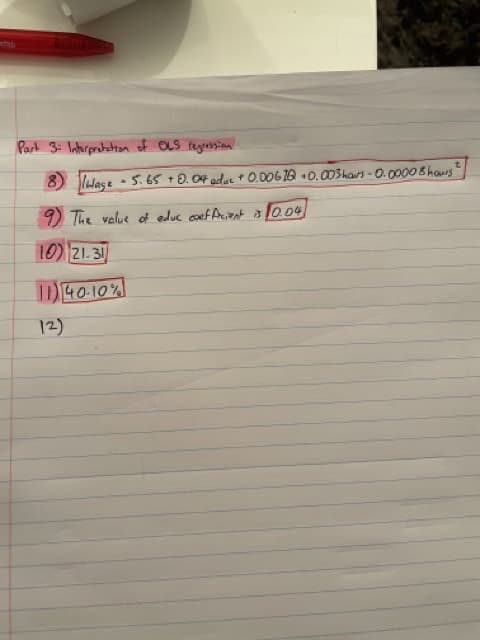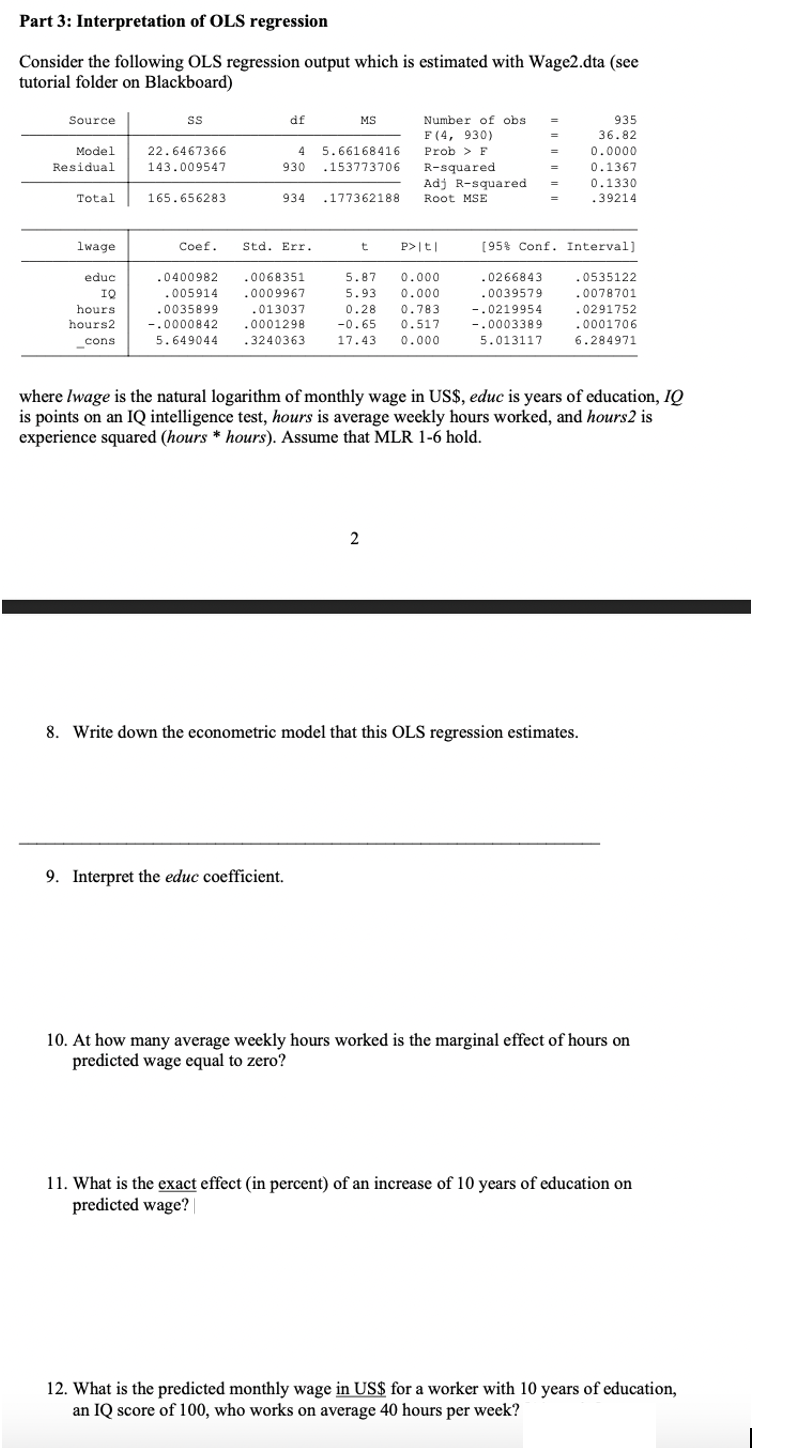Part 3: Interpretation of OLS regression Consider the following OLS regression output which is estimated with Wage2.dta (see tutorial folder on Blackboard) MS 935 36.82 Source ss df Number of obs F (4, 930) Model 22.6467366 4 5.66168416 Prob > F 0.0000 Residual 143.009547 930 .153773706 0.1367 R-squared Adj R-squared Root MSE 0.1330 Total 165.656283 934 .177362188 .39214 lwage Coef. Std. Err. P>|t| (95% Conf. Interval] educ .0400982 .0068351 5.87 0.000 .0266843 .0535122 .0009967 0.000 .005914 .0035899 .0039579 -.0219954 -.0003389 1Q 5.93 .0078701 hours .013037 .0001298 .3240363 0.28 0.783 0.517 0.000 .0291752 hours2 -.0000842 -0.65 .0001706 _cons 5.649044 17.43 5.013117 6.284971 where Iwage is the natural logarithm of monthly wage in US$, educ is years of education, IQ is points on an IQ intelligence test, hours is average weekly hours worked, and hours2 is experience squared (hours * hours). Assume that MLR 1-6 hold. 2 8. Write down the econometric model that this OLS regression estimates. 9. Interpret the educ coefficient. 10. At how many average weekly hours worked is the marginal effect of hours on predicted wage equal to zero? 11. What is the exact effect (in percent) of an increase of 10 years of education on predicted wage? | 12. What is the predicted monthly wage in US$ for a worker with 10 years of education, an IQ score of 100, who works on average 40 hours per week?
Part 3: Interpretation of OLS regression Consider the following OLS regression output which is estimated with Wage2.dta (see tutorial folder on Blackboard) MS 935 36.82 Source ss df Number of obs F (4, 930) Model 22.6467366 4 5.66168416 Prob > F 0.0000 Residual 143.009547 930 .153773706 0.1367 R-squared Adj R-squared Root MSE 0.1330 Total 165.656283 934 .177362188 .39214 lwage Coef. Std. Err. P>|t| (95% Conf. Interval] educ .0400982 .0068351 5.87 0.000 .0266843 .0535122 .0009967 0.000 .005914 .0035899 .0039579 -.0219954 -.0003389 1Q 5.93 .0078701 hours .013037 .0001298 .3240363 0.28 0.783 0.517 0.000 .0291752 hours2 -.0000842 -0.65 .0001706 _cons 5.649044 17.43 5.013117 6.284971 where Iwage is the natural logarithm of monthly wage in US$, educ is years of education, IQ is points on an IQ intelligence test, hours is average weekly hours worked, and hours2 is experience squared (hours * hours). Assume that MLR 1-6 hold. 2 8. Write down the econometric model that this OLS regression estimates. 9. Interpret the educ coefficient. 10. At how many average weekly hours worked is the marginal effect of hours on predicted wage equal to zero? 11. What is the exact effect (in percent) of an increase of 10 years of education on predicted wage? | 12. What is the predicted monthly wage in US$ for a worker with 10 years of education, an IQ score of 100, who works on average 40 hours per week?
Linear Algebra: A Modern Introduction
4th Edition
ISBN:9781285463247
Author:David Poole
Publisher:David Poole
Chapter4: Eigenvalues And Eigenvectors
Section4.6: Applications And The Perron-frobenius Theorem
Problem 22EQ
Related questions
Question
Just need the answer to Q12 please, i have attached my answers to 8-11

Transcribed Image Text:Park 3: latorprahehtan of OLS reyussian
8 llase - 5.65 +0. 04 adut + 0.0061G 0.003hars - 0.0000 Bhars
9) The velue f educ coefArieat 0.04
10) 21. 31
D40-10%
12)

Transcribed Image Text:Part 3: Interpretation of OLS regression
Consider the following OLS regression output which is estimated with Wage2.dta (see
tutorial folder on Blackboard)
Source
ss
df
MS
Number of obs
935
F (4, 930)
36.82
Model
22.6467366
4 5.66168416
Prob > F
0.0000
Residual
143.009547
930
.153773706
R-squared
0.1367
Adj R-squared
0.1330
Total
165.656283
934
.177362188
Root MSE
.39214
1wage
Coef.
Std. Err.
t
P>|t|
[95% Conf. Interval)
educ
.0400982
.0068351
5.87
0.000
.0266843
.0535122
IQ
.005914
.0009967
5.93
0.000
.0039579
.0078701
.0035899
.013037
.0001298
hours
0.28
0.783
-.0219954
.0291752
hours2
-.0000842
5.649044
-0.65
0.517
-.0003389
.0001706
cons
.3240363
17.43
0.000
5.013117
6.284971
where Iwage is the natural logarithm of monthly wage in US$, educ is years of education, IQ
is points on an IQ intelligence test, hours is average weekly hours worked, and hours2 is
experience squared (hours * hours). Assu
me that MLR 1-6 hold.
2
8. Write down the econometric model that this OLS regression estimates.
9. Interpret the educ coefficient.
10. At how many average weekly hours worked is the marginal effect of hours on
predicted wage equal to zero?
11. What is the exact effect (in percent) of an increase of 10 years of education on
predicted wage?||
12. What is the predicted monthly wage in US$ for a worker with 10 years of education,
an IQ score of 100, who works on average 40 hours per week?
Expert Solution
This question has been solved!
Explore an expertly crafted, step-by-step solution for a thorough understanding of key concepts.
Step by step
Solved in 3 steps with 2 images

Recommended textbooks for you

Linear Algebra: A Modern Introduction
Algebra
ISBN:
9781285463247
Author:
David Poole
Publisher:
Cengage Learning

Functions and Change: A Modeling Approach to Coll…
Algebra
ISBN:
9781337111348
Author:
Bruce Crauder, Benny Evans, Alan Noell
Publisher:
Cengage Learning

Glencoe Algebra 1, Student Edition, 9780079039897…
Algebra
ISBN:
9780079039897
Author:
Carter
Publisher:
McGraw Hill

Linear Algebra: A Modern Introduction
Algebra
ISBN:
9781285463247
Author:
David Poole
Publisher:
Cengage Learning

Functions and Change: A Modeling Approach to Coll…
Algebra
ISBN:
9781337111348
Author:
Bruce Crauder, Benny Evans, Alan Noell
Publisher:
Cengage Learning

Glencoe Algebra 1, Student Edition, 9780079039897…
Algebra
ISBN:
9780079039897
Author:
Carter
Publisher:
McGraw Hill

College Algebra
Algebra
ISBN:
9781305115545
Author:
James Stewart, Lothar Redlin, Saleem Watson
Publisher:
Cengage Learning

Big Ideas Math A Bridge To Success Algebra 1: Stu…
Algebra
ISBN:
9781680331141
Author:
HOUGHTON MIFFLIN HARCOURT
Publisher:
Houghton Mifflin Harcourt